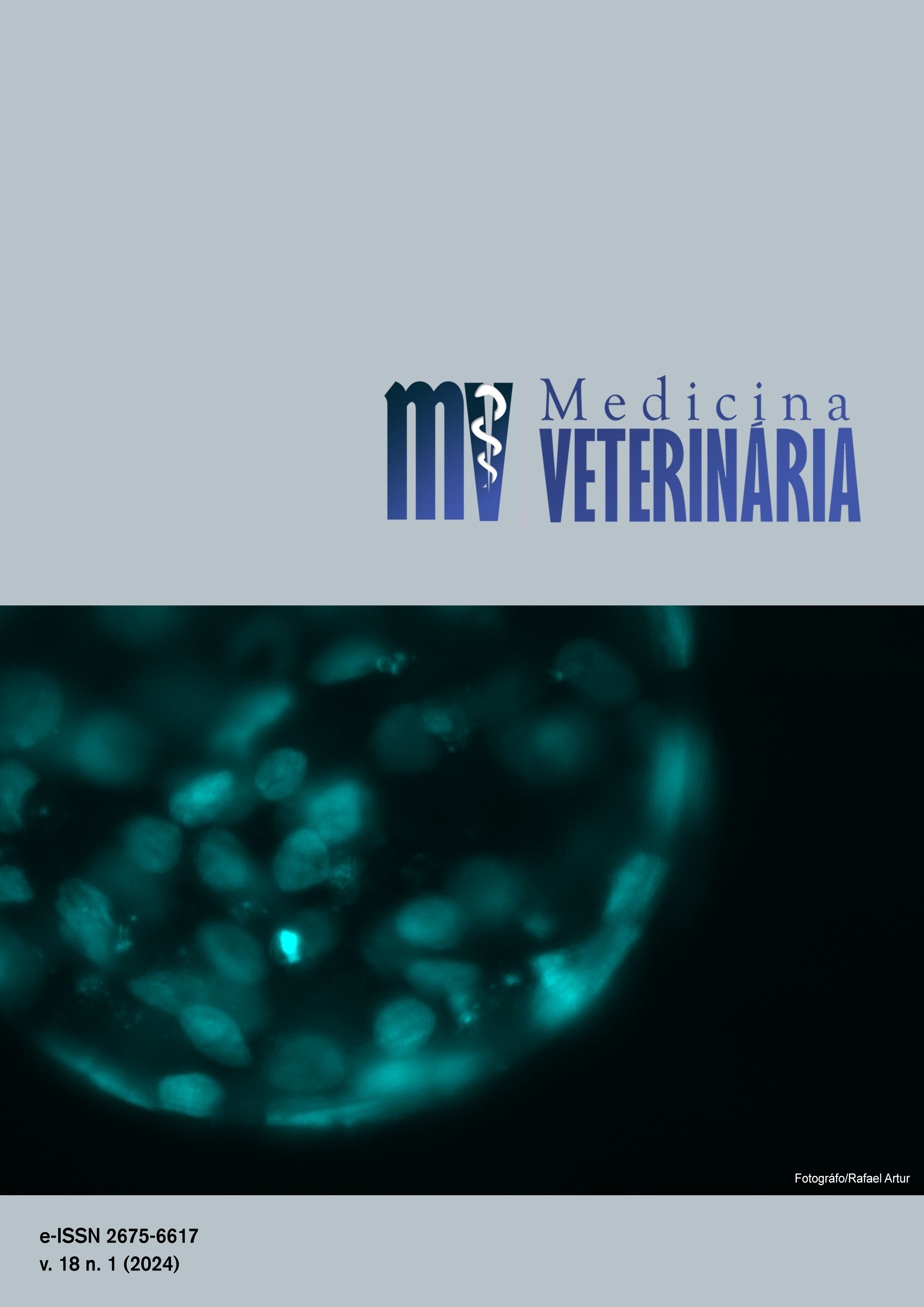Tibial plateau leveling osteotomy for the treatment of cranial cruciate ligament rupture in a dog: case report
DOI:
https://doi.org/10.26605/medvet-v18n1-5931Keywords:
orthopedic surgery; cranial cruciate ligament rupture; TPLOAbstract
The complete or partial rupture of the cranial cruciate ligament (CCRL) results in the loss of stabilization of the knee joint, which is one of the main causes of claudication of the pelvic limb, mainly due to the intense pain caused. Still, the rupture of the cranial cruciate ligament is a condition of considerable casuistry in dogs whose cause is considered multifactorial, without sexual predisposition with greater and prevalence in large and obese dogs. In addition to the clinical disorder, CCL tear can lead to complications that include inflammation of the synovial membrane, osteoarthritis, meniscus injury, and degenerative joint disease. The diagnosis is made through the cranial drawer test and tibial compression, in addition to radiographic confirmation. One of the surgical techniques for correction of CCL tear is the tibial plateau leveling osteotomy (TPLO), which has the morphofunctional objective of altering the anatomical angulation through osteotomy, rotation and stabilization of the proximal portion of the tibia. The change in biomechanics restricts joint activation, causing dynamic neutralization of the cranial tibial stimulus. In view of the data, the work aims to present a TPLO performed in a 9-year-old dog, mixed breed, with an effective result without postoperative complications.Downloads
References
Bergh, M.S.; Peirone, B. Complications of tibial plateau levelling osteotomy in dogs. Veterinary and Comparative Orthopaedics and Traumatology, 25(5): 349-358, 2012.
De Almeida, G.J. et al. Osteotomia de nivelamento do platô tibial (“TPLO”) em cão: Relato de caso. Revista Saber Digital, 9(2): 72-80, 2016.
Dejardin, L.M. Tibial plateau leveling osteotomy. In: Slatter, D. (Ed.) Textbook of Small Animal Surgery. 3a ed. Philadelphia: Saunders, 2003. p.2133-2143.
Fitzpatrick, N.; Solano, M.A. Predictive variables for complications after TPLO with stifle inspection by arthrotomy in 1000 consecutive dogs. Veterinary Surgery, 39(4): 460-474, 2010.
Fuller, M.C. et al. Evaluation of the radiographic infrapatellar fat pad sign of the contralateral stifle joint as a risk factor for subsequent contralateral cranial cruciate ligament rupture in dogs with unilateral rupture: 96 cases (2006–2007). Journal of the American Veterinary Medical Association, 244(3): 328-338, 2014.
Gamble, R. et al. Recommendations for the medical management of osteoarthritis of the hip and knee. Arthritis Rheum, 43(9): 1905-1915, 2000.
Grierson, J.; Asher, L.; Grainger, K. An investigation into risk factors for bilateral canine cruciate ligament rupture. Veterinary and Comparative Orthopaedics and Traumatology, 24(3): 192-196, 2011.
Harasen, G. Canine cranial cruciate ligament rupture in profile: 2002–2007. The Canadian Veterinary Journal, 49(2): 193, 2008.
Johson, A.L. Fundamentos de Cirurgia Ortopédica e Tratamento de Fraturas. In: Fossum, T. Cirurgia de Pequenos Animais. 5ª ed. São Paulo: Elsevier Brasil, 2021. Cap. 32, p.2935-2937.
Kowaleski, M.P.; Boudrieaul, R.J.; Pozzi, A. Stifle Joint. In: Tobias, K.M.; Johnston, S.A. Veterinary Surgery Small Animal. 1a ed. Missouri: Elsevier Saunders, 2011. p.947-955.
Mossman, H. et al. Accuracy of three pre-and intraoperative measurement techniques for osteotomy positioning in the tibial plateau levelling procedure. Veterinary and Comparative Orthopedics and Traumatology, 28(04): 250-255, 2015.
Muir, P. Caudal Cruciate Ligament Rupture. In: _____. Advances in the Canine Cranial Cruciate Ligament. 2a ed. Hoboken, NJ: Wiley, 2018. p.109-111.
Oliveira, R.R. et al. Radiografia e ultrassonografia no diagnóstico da ruptura do ligamento cruzado cranial em cães. Pesquisa Veterinária Brasileira, 29(8): 661-665, 2009.
Piermattei, D.L.; Flo, G.L; DeCamp, C.E. A articulação do joelho. In: ____. Brinker, Piermattei e Flo - Ortopedia e tratamento de fraturas de pequenos animais. 4a ed., São Paulo: Manole, 2009. p.637-717.
Pozzi, A. et al. Stifle Joint. In: Tobias, K.M.; Johnston, S.A. Veterinary Surgery: Small Animal. 2a ed. St. Louis: Saunders, 2018. Vol.1, cap. 4, p.906-999.
Raske, M. et al. Stabilization of the CORA based leveling osteotomy for treatment of cranial cruciate ligament injury using a bone plate augmented with a headless compression screw. Veterinary Surgery, 42(6): 759-764, 2013.
Reif, U.; Probst, C.W. Comparison of tibial plateau angles in normal and cranial cruciate deficient stifles of Labrador retrievers. Veterinary Surgery, 32(4): 385-389, 2003.
Schulz, S.K. Afecções Articulares. In: Fossum, T.W.; Hedlund, C.S.; Johnson, A.L.; Schulz, K.S.; Seim, H.B.; Willard, M.D.; Bahr, A.; Carroll, G.L. Cirurgia de Pequenos Animais. 4a ed. Rio de Janeiro: Mosby, Elsevier, 2015. Cap. 34, p.3437-3457.
Schuster, L.A.H. Estudo retrospectivo de cães portadores de ruptura de ligamento cruzado (2008-2012). Trabalho de Conclusão de Curso (Residência em Clínica Médica de Pequenos Animais). Universidade Federal de Santa Maria, Rio Grande do Sul, 2013. 33p.
Souza, E.S. Estudo retrospectivo sobre a alteração do ângulo do plateau tibial durante a cicatrização óssea da TPLO em cães e execução prática da técnica de TPLO em cadáveres de cão. Tese de Doutorado. Universidade de Lisboa (Portugal), 2020. 130p.
Vasseur, P.B. Stifle joint. In: Slatter, D. Textbook of Small Animal Surgery. 3a ed. Philadelphia: Saunders, 2003. Vol.1, cap.147, p.2090-2116.
Downloads
Published
How to Cite
Issue
Section
License
Copyright (c) 2024 Claudia Natsuki Honda, Ana Beatriz Santana Silva, Gabriela de Assis dos Santos, João Manoel Magalhães Almeida Bezerra, Larissa Teixeira Pacheco, Philipi Coutinho de Souza

This work is licensed under a Creative Commons Attribution-NonCommercial-ShareAlike 4.0 International License.
A Revista de Medicina Veterinária permite que o autor retenha os direitos de publicação sem restrições, utilizando para tal a licença Creative Commons CC BY-NC-SA 4.0.
De acordo com os termos seguintes:
Atribuição — Você deve dar o crédito apropriado, prover um link para a licença e indicar se mudanças foram feitas. Você deve fazê-lo em qualquer circunstância razoável, mas de nenhuma maneira que sugira que o licenciante apoia você ou o seu uso.
NãoComercial — Você não pode usar o material para fins comerciais.
CompartilhaIgual — Se você remixar, transformar, ou criar a partir do material, tem de distribuir as suas contribuições sob a mesma licença que o original.
Sem restrições adicionais — Você não pode aplicar termos jurídicos ou medidas de caráter tecnológico que restrinjam legalmente outros de fazerem algo que a licença permita.







